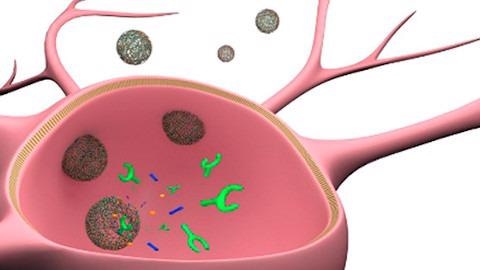Jun 2 2021
Parkinson’s disease (PD) is a general neurodegenerative disorder that occurs due to the death of dopaminergic neurons in a part of the brain (called substantia nigra pars compacta), which results in a lack of dopamine (DA), one of the principal neurotransmitters active in the central nervous system.
 Nanoencapsulation of dopamine. Image Credit: ICN2/IBB-UAB.
Nanoencapsulation of dopamine. Image Credit: ICN2/IBB-UAB.
The focus of symptomatic treatment for PD is to increase the concentration of dopamine in the brain. But dopamine is not administered directly since it cannot cross the supposed blood-brain barrier, which helps prevent penetration of certain substances that circulate in the blood into the nervous system.
Therefore, a DA precursor called levodopa (L-DOPA)—an amino acid that takes part in dopamine synthesis—is used because of its improved potential to cross such a barrier. However, the lasting and intermittent administration of this drug has been connected with significant disabling adversities, like involuntary muscle movements and motor disorders.
In a study reported recently in the journal ACS Nano, synthetic melanin-like nanoparticles have been utilized to overcome such drawbacks.
This study was coordinated by Dr Daniel Ruiz-Molina, leader of the ICN2 Nanostructured Functional Materials Group, and Dr Julia Lorenzo, leader of the Protein Engineering Group at the Institute of Biotechnology and Biomedicine (IBB) of the Universitat Autònoma de Barcelona (UAB), and was further developed in collaboration with the Neurodegenerative Diseases group of Vall d’Hebron Research Institute (VHIR), guided by Professor Miquel Vila.
The study’s primary goal was to achieve a “nanoplatform”—a biocompatible nanostructure containing the substance to be delivered—that can reach the brain with the help of a noninvasive route and produce a slow and regulated dopamine release.
A custom-made nanoscale coordination polymer (NCP), marked by the reversible incorporation of DA as its main component, was tested in vivo and in vitro in rats.
Intranasal administration of such nanoparticles, known as DA-NCPs, exhibited appropriate biocompatibility, non-toxicity, as well as a quick and efficient distribution of dopamine in the animals’ in the central nervous system (avoiding the blood-brain barrier).
The team reports that the new technique has been proven to be effective in providing dopamine to the brain and, thereby, inverting Parkinson’s symptoms. Besides, the synthetic methodology is easy, inexpensive, and displayed an acceptable yield (with a DA loading efficiency ranging up to 60%).
The study results make nanoscale coordination polymers potential future candidates for efficient nasal delivery of drugs to the central nervous system, and hence for the symptomatic treatment of people suffering from Parkinson’s and other neurodegenerative disorders.
Such a nano-formulation and administration route might also set the stage for the advent of other platforms capable of delivering an extensive range of drugs into the brain in a regulated manner, to treat several brain diseases (like Epilepsy, Alzheimer’s, and brain tumors).
Journal Reference:
García-Pardo, J., et al. (2021) Bioinspired Theranostic Coordination Polymer Nanoparticles for Intranasal Dopamine Replacement in Parkinson’s Disease. ACS Nano. doi.org/10.1021/acsnano.1c00453.